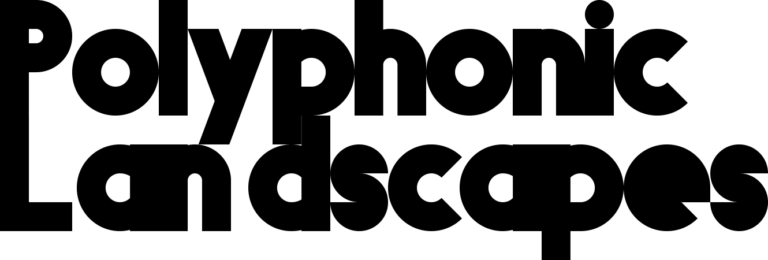
In our current predicament in which we seek new relations to the world around us, the concept of landscape begs for new meanings. Where landscape historically has been thought of as a picturesque vista or passive backdrop for human protagonists, contemporary artists and theorists conceptualize landscape not so much as a noun but as a verb, a continuous flux of becoming in which both human and more-than-human agencies are entangled in a polyphony of ‘world making’, i.e. landscaping.
The artistic research project Polyphonic Landscapes explores how sound and the act of listening can contribute to a more active understanding of landscapes. How can our sense of hearing foster a more embodied, inclusive, relational, and reciprocal connectivity to our environment, in which different life forms, materials, energy flows and temporalities are involved?
Four sound artists have been invited to explore these questions over the course of one year: Budhaditya Chattopadhyay (IN/NL), Yolande Harris (UK/US), Teemu Lehmusruusu (FI) and Lia Mazzari (IT/UK). During residencies in and around the Amstelpark, the artists are working on new sound works that facilitate embodied and situated ways of knowing and experiencing landscape. The progression of their investigations will be shared during three public research seminars, a publication and an exhibition at Zone2Source.
About the artists
Budhaditya Chattopadhyay
Co-Sounding: Towards a
Sonorous Land
Consisting of a series of framed canvasses equipped with sensors, code and field recordings, this installation sets out to decolonise the visual dominance of the static landscape painting by representing landscape through our more intimate senses of sound and hearing. Spilling
over the canvas into the space with sound recordings from locations inspired by 17th century landscape paintings, the audience participates through movement and environmental sensors installed in the canvasses.
Budhaditya Chattopadhyay (IN/NL) is a contemporary artist, researcher, and writer. He produces works for largescale installations and live performance addressing issues of environment and ecology, migration, race, and decoloniality. Chattopadhyay has an expansive body of scholarly publications in artistic research, media theory and aesthetics.
Credits:
Electronics Assembly Support: Bidisha Das (Cologne).
Systems and Production Support: Tobias Lintl (Vienna)
Coding Support: Christoph Kummerer (Vienna)
Thanks to Rijksmuseum Schiphol, Academy of Creative and Performing Arts (ACPA), Critical Media Lab Basel, Lukas Willmann, Gregor Lintl, Lilli Müller, and Gina Müller.
Yolande Harris
Vertigo and the Sound Portal
The global ecological crisis is demanding us to relate to environmental urgencies in far away places. Vertigo and the Sound Portal is a sound and video installation which connects us to distant environments through sound and listening. Encouraging a heightened sensitivity and relational reorientation it celebrates an amorphous, fluid relationship to place and identity through the concept of vertigo. How do we hear displaced sounds, or sense remote presence and connections with landscapes far away from us? Connecting the Pacific coast of central California with the Amstelpark in Amsterdam, visitors are invited to consider how their fixed concept of geographical and ecological location, and the accompanying sense of identity, is extended, amplified and liquefied through sound.
Yolande Harris (UK/US) is an artist, musician and researcher exploring ideas of sonic consciousness. Through audio-visual installations, walks and performances she creates intimate visceral experiences that heighten awareness of our relationship to the environment.
Click here to learn more about Vertigo and the Sound Portal
Teemu Lehmusruusu
Pulse
Pulse is a sonically resonating bronze and glass sculpture, a type of human-to-soil probe.With the help of moisture and temperature sensors, the sculpture connects us to the underground bioactivity of the environment in which it is placed. Aiming to reposition us to the landscape, the work probes the invisible soil processes by translating them into sonic experiences and inviting us to resonate with a vital underground system. The sculpture creates a site of attention to those fragile conditions of life that lie below our feet, and that we classically do not understand to be part of the flat idea of ‘landscape’. Instead landscape is understood as ways of encounter the dynamism of a materially resonating, esthetical experience between bodies.
Teemu Lehmusruusu (FI) is a Helsinki-based media and installation artist. Lehmusruusu’s current, long-term exploration is into the invisible life within the Earth’s soil, that is in a constant state of flux, and endangered by the environmental crisis. He enables us to encounter it through sensors, sounds and computer-generated images together with natural materials.
Lia Mazzari
hydroFiles
hydroFiles explores how live audio streaming engenders different modalities of ‘being and listening with’ our planet. It consists of a network of eight live audio streams continuously broadcasting from various sites above and below the waterways of Amsterdam, such as canals, bridges and the dunes. By placing microphones and hydrophones across surfaces, drinking, sewage waters
and giving the Amstel waters a voice, the live audio streams transform the act of listening to into listening with environments.
Lia Mazzari (IT/UK) is a sound artist and researcher. She engages audiences through encounters with art in non-conventional spaces (on-site and online) using performance, composition, installation, and intervention. Recorded and live events explore how sound can be used as a multidimensional force of acoustic commoning.
hydroFiles is supported by Waterschap Amstel, Gooi en Vecht and by Waternet.
Polyphonic Landscapes is a joint project by Zone2Source and Professorship Theory in the Arts, ArtEZ University of the Arts
Dr. Peter Sonderen, responsible professor
Joep Christenhusz, MA, project leader
Alice Smits, Director Zone2Source
Educational partners:
Honours Lab, ArtEZ University of the Arts
Polyphonic Landscapes is part of the Art Route NWA-project Bit by bit, or not at all within the scheme ‘Small Projects’, financed by the Dutch Research Council (NWO).
The Glass House